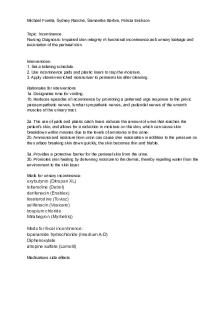Maternity Nursing diagnosis for OBGYN Clinical PDF

| Title | Maternity Nursing diagnosis for OBGYN Clinical |
|---|---|
| Author | Stacy Downing |
| Course | Nursing And Healthcare V: Family Health Clinical |
| Institution | Towson University |
| Pages | 4 |
| File Size | 94.5 KB |
| File Type | |
| Total Downloads | 71 |
| Total Views | 165 |
Summary
Maternity Nursing diagnosis for OBGYN Clinical...
Description
Maternity/Newborn Nursing Diagnosis How to prioritize when choosing a nursing diagnosis 1. 2. 3. 4. 5. 6.
List the patients issues/problems after completing your worksheet Ask yourself which problem or issue is more important? Why?
Ask yourself what is most important to the patient. Decide if they are real or potential problems-Real problems take priority Decide if they are acute or chronic problems-Acute problems take priority Decide if they are physical or Psychosocial problem (hint pain is psychosocial)Real physical problems take priority over Real Psychosocial problems 7. Do any of the problems effect the patients airway, breathing or circulation?These problems take priority
Newborn Nursing Diagnosis 1) Ineffective breastfeeding (** can also be a maternal diagnosis)
Poor latch, latch scores less than 8 Pain during breastfeeding Significant weight loss in a breastfed baby 10% or greater Decreased output in a breastfeed baby
2) Ineffective infant feeding pattern 3) Imbalanced nutrition: less than body requirements
4) Risk for Neonatal Jaundice
RH neg mother Coombs positive Preterm/Late Preterm Increased weight loss Breastfed infant
5) Ineffective Thermoregulation (Risk for)
Preterm/Late preterm Low blood sugars Documented low temperatures Small for gestational age or IUGR infants
6) Nutrition Imbalance
Poor weight gain
7) Risk for sudden infant death syndrome
Teen parent Maternal smoking Smoking in the household All newborns
8) Risk for unstable blood glucose level
Infant with Low temperatures Small for gestational age infants Large for gestational age infants Infants of a Diabetic mother Jittery infant
9) Risk for imbalanced body temperature
Infant consistently not swaddled or dressed appropriately
Maternal Diagnosis 1) Bleeding (Risk for)
Vaginal delivery or C-section Postpartum Hemorrhage after birth Retained placenta Boggy fundus Circumcision (newborn) Vacuum or forceps delivery Use of magnesium sulfate during labor Infection Multiple birth Vaginal Hematoma
2) Constipation (Risk for)
Decreased bowel sounds C-section A patient that refuses to ambulate Narcotic use Episiotomy
3) Infection (Risk for) *** could also be used for newborn
Increased temp (newborn and maternal) GBS + (newborn) Meconium stained amniotic fluid (newborn and maternal) Prolonged rupture of membranes > than 12 hours (newborn and maternal) C-section Episiotomy/Laceration repair
4) Impaired urinary elimination (Risk for) *** could also be used for newborn
Recent foley catheter removal Epidural or Spinal Vaginal or C-Section delivery Post circumcision (newborn)
5) Ineffective airway clearance (Risk for) *** could also be used for newborn
Post op C-section Recently delivered newborn (newborn)
6) Impaired tissue perfusion (Risk for)
Preeclampsia HTN Hypotension DVT
7) Insufficient Breast Milk
Mom not making enough milk
10) Interrupted breastfeeding
Psychosocial diagnosis Anxiety Impaired parenting (risk for)
Single parent Lack of resources (financial, social etc.) Teen parent
Depression (Risk for)
History of anxiety or depression NiCU baby Traumatic delivery
Impaired comfort
Labor Episiotomy Laceration
Acute Pain
Labor Circumcision Post-delivery Episiotomy or laceration
Vaginal Hematoma
Dysfunctional family processes Risk for disturbed maternal-fetal dyad
Labor and Delivery Specific Ineffective Childbearing Process Risk for Ineffective Child Bearing Process
Readiness for Don’t forget there are Readiness or Wellness Diagnosis- Assessing a patient's readiness to respond to a wellness diagnosis involves patient interviews and interaction. These only involve one part no r/t or aeb. Examples.. Readiness for enhanced immunization status, Readiness for enhanced parenting…. Readiness for enhanced breastfeeding, Readiness for enhanced childbearing process, Readiness for enhanced organized infant behavior...
Similar Free PDFs

Nursing Diagnosis for MIU
- 1 Pages

Nursing Diagnosis for Sepsis
- 8 Pages

Nursing diagnosis
- 2 Pages

Nursing Diagnosis
- 5 Pages

Nanda Nursing Diagnosis
- 7 Pages

Nanda Nursing Diagnosis list
- 16 Pages

Nursing diagnosis by maslows
- 9 Pages

Nursing Diagnosis FVD
- 1 Pages

MN Nursing Diagnosis for NPR-1
- 4 Pages
Popular Institutions
- Tinajero National High School - Annex
- Politeknik Caltex Riau
- Yokohama City University
- SGT University
- University of Al-Qadisiyah
- Divine Word College of Vigan
- Techniek College Rotterdam
- Universidade de Santiago
- Universiti Teknologi MARA Cawangan Johor Kampus Pasir Gudang
- Poltekkes Kemenkes Yogyakarta
- Baguio City National High School
- Colegio san marcos
- preparatoria uno
- Centro de Bachillerato Tecnológico Industrial y de Servicios No. 107
- Dalian Maritime University
- Quang Trung Secondary School
- Colegio Tecnológico en Informática
- Corporación Regional de Educación Superior
- Grupo CEDVA
- Dar Al Uloom University
- Centro de Estudios Preuniversitarios de la Universidad Nacional de Ingeniería
- 上智大学
- Aakash International School, Nuna Majara
- San Felipe Neri Catholic School
- Kang Chiao International School - New Taipei City
- Misamis Occidental National High School
- Institución Educativa Escuela Normal Juan Ladrilleros
- Kolehiyo ng Pantukan
- Batanes State College
- Instituto Continental
- Sekolah Menengah Kejuruan Kesehatan Kaltara (Tarakan)
- Colegio de La Inmaculada Concepcion - Cebu






